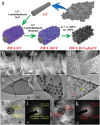Hierarchical Co3O4 Nano-Micro Arrays Featuring Superior Activity as Cathode in a Flexible and Rechargeable Zinc-Air Battery
- PMID: 31179211
- PMCID: PMC6548986
- DOI: 10.1002/advs.201802243
Hierarchical Co3O4 Nano-Micro Arrays Featuring Superior Activity as Cathode in a Flexible and Rechargeable Zinc-Air Battery
Abstract
All-solid-state zinc-air batteries are characterized as low cost and have high energy density, providing wearable devices with an ideal power source. However, the sluggish oxygen reduction and evolution reactions in air cathodes are obstacles to its flexible and rechargeable application. Herein, a strategy called MOF-on-MOF (MOF, metal-organic framework) is presented for the structural design of air cathodes, which creatively develops an efficient oxygen catalyst comprising hierarchical Co3O4 nanoparticles anchored in nitrogen-doped carbon nano-micro arrays on flexible carbon cloth (Co3O4@N-CNMAs/CC). This hierarchical and free-standing structure design guarantees high catalyst loading on air cathodes with multiple electrocatalytic activity sites, undoubtedly boosting reaction kinetics, and energy density of an all-solid-state zinc-air battery. The integrated Co3O4@N-CNMAs/CC cathode in an all-solid-state zinc-air battery exhibits a high open circuit potential of 1.461 V, a high capacity of 815 mAh g-1 Zn at 1 mA cm-2, a high energy density of 1010 Wh kg-1 Zn, excellent cycling stability as well as outstanding mechanical flexibility, significantly outperforming the Pt/C-based cathode. This work opens a new door for the practical applications of rechargeable zinc-air batteries in wearable electronic devices.
Keywords: Co3O4; nano‐micro arrays; cathodes; superior activities; zinc–air batteries.
Conflict of interest statement
The authors declare no conflict of interest.
Figures





Similar articles
-
Frontiers and Structural Engineering for Building Flexible Zinc-Air Batteries.Adv Sci (Weinh). 2022 Feb;9(6):e2103954. doi: 10.1002/advs.202103954. Epub 2021 Dec 22. Adv Sci (Weinh). 2022. PMID: 34939351 Free PMC article. Review.
-
Doping-engineered bifunctional oxygen electrocatalyst with Se/Fe-doped Co3O4/N-doped carbon nanosheets as highly efficient rechargeable zinc-air batteries.J Colloid Interface Sci. 2022 Nov 15;626:475-485. doi: 10.1016/j.jcis.2022.06.147. Epub 2022 Jun 28. J Colloid Interface Sci. 2022. PMID: 35803146
-
Hollow Co3 O4 Nanosphere Embedded in Carbon Arrays for Stable and Flexible Solid-State Zinc-Air Batteries.Adv Mater. 2017 Nov;29(44). doi: 10.1002/adma.201704117. Epub 2017 Oct 12. Adv Mater. 2017. PMID: 29024075
-
Phosphorus/nitrogen co-doped and bimetallic MOF-derived cathode for all-solid-state rechargeable zinc-air batteries.RSC Adv. 2020 Sep 10;10(55):33327-33333. doi: 10.1039/d0ra04827e. eCollection 2020 Sep 7. RSC Adv. 2020. PMID: 35515043 Free PMC article.
-
An Overview and Future Perspectives of Rechargeable Flexible Zn-Air Batteries.ChemSusChem. 2024 Sep 9;17(17):e202400080. doi: 10.1002/cssc.202400080. Epub 2024 May 22. ChemSusChem. 2024. PMID: 38533691 Review.
Cited by
-
Soft Materials for Wearable/Flexible Electrochemical Energy Conversion, Storage, and Biosensor Devices.Materials (Basel). 2020 Jun 16;13(12):2733. doi: 10.3390/ma13122733. Materials (Basel). 2020. PMID: 32560176 Free PMC article. Review.
-
Frontiers and Structural Engineering for Building Flexible Zinc-Air Batteries.Adv Sci (Weinh). 2022 Feb;9(6):e2103954. doi: 10.1002/advs.202103954. Epub 2021 Dec 22. Adv Sci (Weinh). 2022. PMID: 34939351 Free PMC article. Review.
-
Co3O4 Nanoneedle Array Grown on Carbon Fiber Paper for Air Cathodes towards Flexible and Rechargeable Zn-Air Batteries.Nanomaterials (Basel). 2021 Dec 7;11(12):3321. doi: 10.3390/nano11123321. Nanomaterials (Basel). 2021. PMID: 34947675 Free PMC article.
-
A Porphyrinic Zirconium Metal-Organic Framework for Oxygen Reduction Reaction: Tailoring the Spacing between Active-Sites through Chain-Based Inorganic Building Units.J Am Chem Soc. 2020 Sep 9;142(36):15386-15395. doi: 10.1021/jacs.0c06329. Epub 2020 Aug 26. J Am Chem Soc. 2020. PMID: 32786758 Free PMC article.
-
Recent Advances on MOF Derivatives for Non-Noble Metal Oxygen Electrocatalysts in Zinc-Air Batteries.Nanomicro Lett. 2021 Jun 7;13(1):137. doi: 10.1007/s40820-021-00669-5. Nanomicro Lett. 2021. PMID: 34138394 Free PMC article. Review.
References
-
- Guan C., Sumboja A., Zang W., Qian Y., Zhang H., Liu X., Liu Z., Zhao D., Pennycook S. J., Wang J., Energy Storage Mater. 2019, 16, 243.
-
- An L., Li Y., Luo M., Yin J., Zhao Y.‐Q., Xu C., Cheng F., Yang Y., Xi P., Guo S., Adv. Funct. Mater. 2017, 27, 1703779.
-
- Yang H., Wang B., Li H., Ni B., Wang K., Zhang Q., Wang X., Adv. Energy Mater. 2018, 8, 1801839.
-
- Yang L., Shi L., Wang D., Lv Y., Cao D., Nano Energy 2018, 50, 691.
LinkOut - more resources
Full Text Sources
